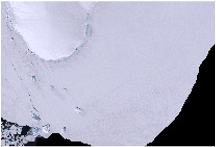Antarctic Meteorite Stranding Zones
Meteorites that fall in Antarctica typically become embedded in the ice sheet. Due to ice flow and surface processes, a small fraction of all meteorites in the ice resurface in some of the continent’s blue ice areas. The contrasting blue ice makes it easy to detect and collect meteorites during Antarctic field work missions.
Meteorites are too small to detect from space, but with indirect satellite measurements (temperature, speed of the ice flow, the surface slope, and the way the ice reflects radar signals) and machine learning, we can predict where meteorites concentrate at the surface. Explore the results of our research (Tollenaar et al., Science Advances, 2022, doi: 10.1126/sciadv.abj8138) - where would you go to catch a falling star?
Our research was possible thanks to (the contributions to) the Meteoritical Bulletin Database. Results will improve with additional data, on both succesful and unsuccesful meteorite searching campaigns. Sharing this data is encouraged. Comments are welcome, contact details are provided in the publication.
 |
Outlines of identified meteorite stranding zones |
 |
Probability to find meteorites |
 |
Stations as listed by COMNAP |
 |
Center filled LIMA (Landsat Image Mosaic Antarctica Project) |
| Maximum temperature | MODIS MOD11A2.006 |
| Ice flow velocity | MEaSUREs Phase-Based Antarctica Ice Velocity Map, Version 1 |
| Snow-free days | MODIS MCD43A3.006 |
| Methods | Unexplored Antarctic meteorite collection sites revealed through machine learning |